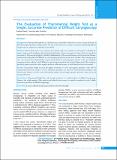Please use this identifier to cite or link to this item:
https://hdl.handle.net/20.500.14356/1285Full metadata record
| DC Field | Value | Language |
|---|---|---|
| dc.contributor.author | Rawal, Prabhat | - |
| dc.contributor.author | Shrestha, Surendra Man | - |
| dc.date.accessioned | 2023-05-04T08:09:49Z | - |
| dc.date.available | 2023-05-04T08:09:49Z | - |
| dc.date.issued | 2020 | - |
| dc.identifier.citation | RawalP., & ShresthaS. M. (2020). The Evaluation of Thyromental Height Test as a Single, Accurate Predictor of Difficult Laryngoscopy. Journal of Nepal Health Research Council, 18(2), 271-276. https://doi.org/10.33314/jnhrc.v18i2.2259 | en_US |
| dc.identifier.issn | Print ISSN: 1727-5482; Online ISSN: 1999-6217 | - |
| dc.identifier.uri | http://103.69.126.140:8080/handle/20.500.14356/1285 | - |
| dc.description | Original Article | en_US |
| dc.description.abstract | Abstract Background: Thyromental Height Test is a relatively new, easy method considered as a more accurate predictor of difficult laryngoscopy than existing methods. The aim of this study was to evaluate its accuracy in predicting difficult laryngoscopy as compared to commonly used methods. Methods: This hospital based, cross-sectional, observational study was conducted on 246 patients scheduled for surgery under general anesthesia with endotracheal intubation. Airway assessment was done during pre-anesthetic assessment by Thyromental Height Test, Modified Mallampati Test, Thyromental Distance and Sternomental Distance measurements and predicted as ‘difficult’ or ‘easy’ laryngoscopy based on accepted cut-off values. Direct laryngoscopic view was assessed after administration of general anesthesia by a laryngoscopist unaware of the pre-anesthetic assessments and recorded as ‘actual’ difficult or easy laryngoscopy based on Cormack-Lehane grades. The sensitivity, specificity, positive predictive value, negative predictive value and accuracy of each clinical test were determined. Results: Thyromental Height Test had the highest sensitivity (71.42%) and negative predictive value (98.9% respectively) but lowest accuracy (77.2%). Maximum specificity was observed with Thyromental Distance and Sternomental Distance (97.49% each). Thyromental Distance had the highest positive predictive value (25%) and accuracy (95.52%). Conclusions: Thyromental Height Test, with its high sensitivity, is a useful predictor of difficult laryngoscopy. However, due a high number of false positives and relatively low accuracy, it cannot be considered as a sole, reliable and accurate predictor of difficult laryngoscopy. Keywords: Accuracy; difficult laryngoscopy; predictor; thyromental height | en_US |
| dc.language.iso | en | en_US |
| dc.publisher | Nepal Health Research Council | en_US |
| dc.relation.ispartofseries | Apr-June, 2020;2259 | - |
| dc.subject | Accuracy | en_US |
| dc.subject | difficult laryngoscopy | en_US |
| dc.subject | predictor | en_US |
| dc.subject | thyromental height | en_US |
| dc.title | The Evaluation of Thyromental Height Test as a Single, Accurate Predictor of Difficult Laryngoscopy | en_US |
| dc.type | Journal Article | en_US |
| local.journal.category | Original Article | - |
| Appears in Collections: | Vol. 18 No. 2 Issue 47 Apr-Jun 2020 | |
Files in This Item:
| File | Description | Size | Format | |
|---|---|---|---|---|
| 2259-Manuscript-17530-1-10-20200911.pdf | Fulltext Download | 260.8 kB | Adobe PDF |  View/Open |
Items in DSpace are protected by copyright, with all rights reserved, unless otherwise indicated.
